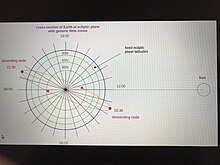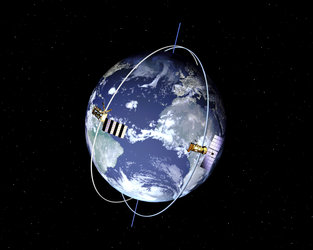- Polar Orbit Vs Sun Synchronous Orbit
- Sun Synchronous Polar Orbit In Hindi
- What Is A Sun Synchronous Orbit
The 1360 kg RESOURCESAT-1 was launched into an 817 km high polar sun synchronous orbit by the eighth flight of India's Polar Satellite Launch Vehicle (PSLV-C5). WikiMatrix The spacecraft was placed in a 525 km (326 mi), circular, polar, Sun - synchronous orbit for its ten-month mission, during which it has taken 1.5 million images, one every. A sun-synchronous orbit passes by any given point with the same local solar time, which is useful for consistent lighting and sun angle. Out of the three types of orbits (low, medium, and high Earth orbits), polar orbits often fall into low Earth orbits. Depending on orbital altitudes, angular velocities, and inclinations, polar orbiting satellites can be sun-synchronous, that is, they cross the equator southbound about 11 deg. Westward (as Earth rotates underneath) with each trip around the world (about 105 minutes long), so that they cross some reference position (e.g., the equator) at the same local time.
- Summer vacation plans changed for many in 2020. Whatever your plans, Landsat can take you on a virtual road trip. Landsat 8, in its sun-synchronous polar orbit, views every national park in the U.S. Every 16 days and gathers more photographic data than the most ambitious of tourists.
- A sun-synchronous orbit is an orbit around the Earth, where the movement of the satellite always looks the same when viewed from the Sun. A satellite in a sun-synchronous orbit still orbits the Earth, but does so in such a way that over the course of the day, its distance to the Sun will change in a consistent pattern no matter the time of year.
Polar Orbiting Environmental Satellites (POES)
Due to the rotation of the Earth, it is possible to combine the advantages of low-altitude orbits with global coverage, using near-polar orbiting satellites, which have an orbital plane crossing the poles. These satellites, termed Polar Orbiting Environmental Satelliites (POES) are launched into orbits at high inclinations* to the Earth's rotation (at low angles with longitude lines), such that they pass across high latitudes near the poles. Most POES orbits are circular to slightly elliptical at distances ranging from 700 to 1700 km (435 - 1056 mi) from the geoid. At different altitudes they travel at different speeds.
*'High inclination' means that the subsatellite point moves north or south along the surface projection of the earth's axis. If the orbit is designed correctly, the subsatellite point can be largely in the day side (or night side) of the planet during the entire orbit. Such an orbit is termed 'sun-synchronous' and more details on that are given below. Obviously, in order for this to happen, the orbital speed of the saltellite (and its orbital altitude) would have to be phased with the rotation of the earth. The result is that the orbit of the satellite can be phased so that the satellite maximizes its coverage of the the day side of the planet.
The ground track of the POES is displaced to the west after each orbital period, due to the gravitaitonal effects and the rotation of the Earth. This displacement of longitude is a function of the orbital period (often less than 2 hours for low altitude orbits). In essence, while the satellite circles both poles, the portion of the earth at subsatellite point will be in sunlight or darkness during that entire period. The balance between gravitational acceleration and centrifugal acceleration for such satellites requires a low earth (h) orbit, contrasted to the h you calculated in Homework 1 for the GOES.
Fig. 2. Map of the ground path of one revolution of a typical near-polar orbiting satellite.

Fig. 3. The orbit of a near polar satellite as viewed from a point rotating with the Earth.
.


Depending on the ground swath of the satellite, it is possible to adjust the period (by varying the altitude), and thus the longitudinal displacement, in such a way as to ensure the observation of any point on the Earth within a certain time period. Most of the near polar meteorological satellites ensure complete global coverage of the Earth, during one day, thanks to a ground swath of about 3300 km.
Fig. 4. The ground paths of the multiple orbital revolutions during one day for a near-polar orbiting satellite.
Sun-synchronous polar orbiting satellites
Depending on orbital altitudes, angular velocities, and inclinations, polar orbiting satellites can be sun-synchronous, that is, they cross the equator southbound about 11 deg. westward (as Earth rotates underneath) with each trip around the world (about 105 minutes long), so that they cross some reference position (e.g., the equator) at the same local time. This time is usually between mid-morning and mid-afternoon on the sunlight side of the orbit. Sunsynchronous satellites pass over any given latitude at almost the same local time during each orbital pass. Thus they image their swaths at about the same sun time during each pass, so that lighting remains roughly uniform. Of course the clouds change with each orbit, but their broad patterns and positions remain mostly unchanged in the short orbital periods involved. From this method, one can make a daily mosaic from the swaths, which is a good general summary of global weather patterns for that period. This same orbital configuration applies to Landsat, SPOT, and some of the other land observers. In addition, for a given latitude and season, sunsynchronous satellites observe the Earth surface with a nearly constant sunlight ratio. This characteristic is useful for measurements in the visible wavelengths, and also for thermal considerations in keeping with the diurnal cycle.
A dawn-dusk orbit is a special case of a sun-synchronous orbit in which a satellite perpetually trails the shadow of the Earth cast by the Sun. Because the satellite is close to the shadow, the part of the Earth's surface directly below the satellite is always at sunset or sunrise, hence the name of this type of orbit. An advantage of it is that the satellite always has its solar panels bathed in sunlight so that it can produce power by this means continuously. Satellites crossing the equator in the morning (at 7:30 a.m. local time for the original TIROS satellites and between 06 and Noon for the NOAA series) are known as AM satellites (because they appear to ascend in the sky in the morning) and those appearing in the afternoon (1:40 p.m. local time for the original TIROS and 12 and 18 Local Time) as PM satellites.
A sun-synchronous orbit describes the orbit of a satellite that provides consistent lighting of the Earth-scan view. The satellite passes the equator and each latitude at the same time each day. For example, a satellite's sun-synchronous orbit might cross the equator twelve times a day each time at 3:00 p.m. local time. The orbital plane of a sun-synchronous orbit must also precess (rotate) approximately one degree each day, eastward, to keep pace with the Earth's revolution around the sun, so that for each orbit of the satellite, the subsatellite point intersects exactly the same point as it did in the previous segment of twelve transects.

Fig. 5. Example of the positions of a sun-synchronous satellite in 12 hour intervals.
Advantages of sun-synchronous orbits
The low altitude of a sun-synchronous orbit permits good ground resolution. It also enables easier active measurements with radar or lidar. The circular orbit implies a constant satellite velocity, which is important for having a regular scanning resolution along the satellite ground track. The near polar orbit allows a global coverage for the observation of the whole Earth. Orbit altitudes of between 700 and 900 km permits both a large ground swath, offering a daily global coverage, and a good ground resolution. Most of the Earth observing missions use sun-synchronous satellites in low near polar orbits (NOAA polar orbiting meteorological satellites, Landsat, SPOT, ERS, etc...).
Polar Orbit Vs Sun Synchronous Orbit
Sun-synchronism produces time-constant illumination conditions of the observed surfaces, (except for seasonal variations). This property is useful for many remote-sensing applications in Earth observation. Another property of interest is the nearly constant sunlight ratio of the satellite on each orbit, which implies a near constant solar energy supply for the satellite platform.
Limitations of sun-synchronous orbits
Sun Synchronous Polar Orbit In Hindi
A continuous temporal observation is not possible with only one sun-synchronous satellite. It passes over polar regions on every orbital period (remember, the pole is a point), but much more rarely over the same equatorial regions (2 times a day for most current meteorological satellites; more generally it depends on the drift and the ground swath). A possibility to ease this difficulty could be to use a constellation of satellites. At present this is only envisaged for telecommunication applications and not for Earth observation. For weather forecasting, then, the use of POES data is limited. On the other hand, imagery from the GOES is continuous and frequent over a 24 hour period.
What Is A Sun Synchronous Orbit




